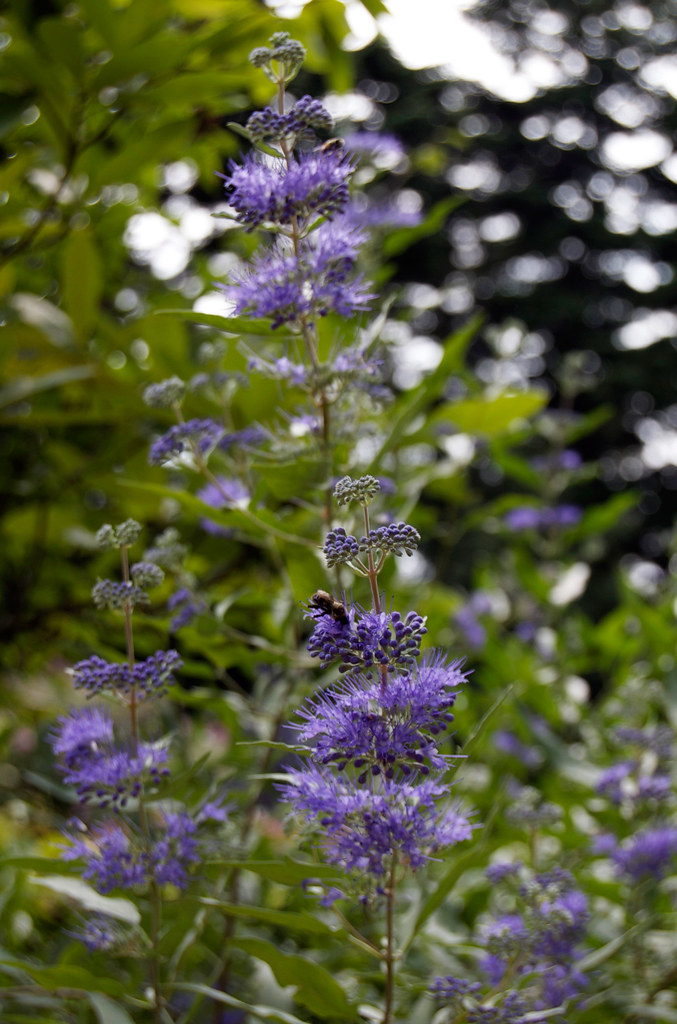Tip of the Week — 2/17/09
Posted in Gardening Tips on February 17 2009, by Sonia Uyterhoeven
The Cutting Edge
 Sonia Uyterhoeven is Gardener for Public Education at The New York Botanical Garden.
Sonia Uyterhoeven is Gardener for Public Education at The New York Botanical Garden.
It’s the time of the year to get outside and evaluate the pruning needs in your yard. February and March tend to be ideal times to prune, not all but many of your shrubs.
 How do you go about deciding what needs to be done? First of all, it is important that you get to know your plants. Some shrubs respond well when pruned back hard every year in winter to early spring. They produce vigorous new growth and more flowers. Classic examples are repeat-flowering roses (e.g. hybrid teas), butterfly bush (Buddleja), and blue mist shrub (Caryopteris), pictured at right.
How do you go about deciding what needs to be done? First of all, it is important that you get to know your plants. Some shrubs respond well when pruned back hard every year in winter to early spring. They produce vigorous new growth and more flowers. Classic examples are repeat-flowering roses (e.g. hybrid teas), butterfly bush (Buddleja), and blue mist shrub (Caryopteris), pictured at right.
Some shrubs such as Japanese andromeda (Pieris), rhododendrons (Rhododendron), and Carolina allspice (Calycanthus) need very little pruning. Other shrubs such as daphne (Daphne) resent pruning and will tell you.
Gardening often involves casualties, and this is just part of the process. Here are some basic guidelines for pruning shrubs and several tips to get you successfully through the season.
Start your pruning by cutting out all dead, damaged, and diseased branches. Then stand back and look at the shrub. Second, remove any branches that are crossing over, deciding which branches to remove and which ones should remain. Step back again and look at the shape that you are left with. You will be amazed at how little pruning you have to do on the majority of your shrubs once you have made these cuts.
Remember that a shrub is like a crowded subway. As long as everyone has their own personal space and enough room to breath, they are happy. Your woody plants are the same. Do not have branches competing for the same space, they will only be unhappy. New wood is more vigorous than old wood, but it is good to have a balance between both so that you have some character and structure along with the young new maverick branches (that tend to be more floriferous). Once you have grasped these concepts, pruning is then a matter of style and personal taste.
Additional tips:
- Never remove more than 20 percent of the growth unless you are rejuvenating a plant.
- Always use sharp, clean tools that are appropriate for the task.
- Shrubs that flower on current season’s growth can be pruned early in the season.
- Shrubs that flower early in the season or flower on old wood (last season’s growth) should be pruned immediately after flowering. Remember that there are always exceptions to the rule, and it is important to know your plant.
- Work with the natural shape of the plant to enhance its natural beauty and structure. This is very important. Working with the plant rather than against it will save you a lot of work.
- Error on the side of caution—if you are not sure about a cut, don’t do it.
Like every other aspect of gardening, have fun, make plenty of mistakes, and learn.


GREAT pruning tips! Thanks!
http://www.greenspacenyc.com/